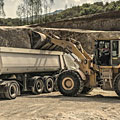Different Methods of Quarrying
December 8, 2017
Even from a distance, you can hear quarrying equipment grinding rocks. The crushing jaws are cracking the quarried material while the deposited stones are conveyed to a screening station. Sorted and classified, the different flinty pebbles are stacked, loaded, and dispatched. Back at the dusty processing line, different quarrying methods are in action. We’re in luck, a new quarry has been sited. What quarrying method do we call upon?
Clear the Area
There won’t be much talk about applications or destinations. The material is bound for a construction site, maybe even a coastal site, a place that requires fortification through riprap accretion. Marble and granite quarrying sites are carefully excavating giant slabs of veined stone and quartz. They’re headed for expensive kitchen counters and bathroom floors, among other places. Back at the initial site, blasting equipment is in place. Hold your ears, the blast is about to go off.
The Delicate Approach
It stands to reason, given the different types of rock trapped in the ground, there must be a few competing quarrying methods in use today. In those quartz and granite slab quarries, for example, valuable minerals are cut free from rocky formations. Special chainsaws and diamond-tipped wire saws work alongside the drilling equipment. As the cuts progress, the slabs are released from the grip of the rock. This raw stony stuff doesn’t look like much, but it will when the polishing equipment is powered into life.
Call In the Heavy Gear
Imagine cracked boulders that are as tall as a single-storey house. In olden days, manually wielded pickaxes and hammers spawned a war of attrition. They split the boulders. Large fires further cracked the heavy stones, but who wanted to wait for that fire? And there’s no way even a musclebound worker could hammer his way through the material, not in the same way a powered digger could. No, a modern quarry takes shape as a series of rings or channels. They bore down into the earth, with excavators rolling along their surfaces. Pneumatic steel drillers then break up the rock. Next, large chainsaws and buzz wheels mounted on hydraulic arms swing into action. They slice the granite into raw chunks while an accompanying fleet of front loaders scoops up the heaped aggregate.
Sheer faces are blasted until black granite and soapstone are exposed. Meanwhile, over at a stone-filled quarry, an army of excavators cracks a rocky formation. The released stones are crushed, screened, and conveyed via a bank of vibratory equipment. Piled for dispatch, the different quarrying methods serve every conceivable construction-centric application, plus that aesthetically inclined field we know as interior decoration.
Optimized by: Netwizard SEO


